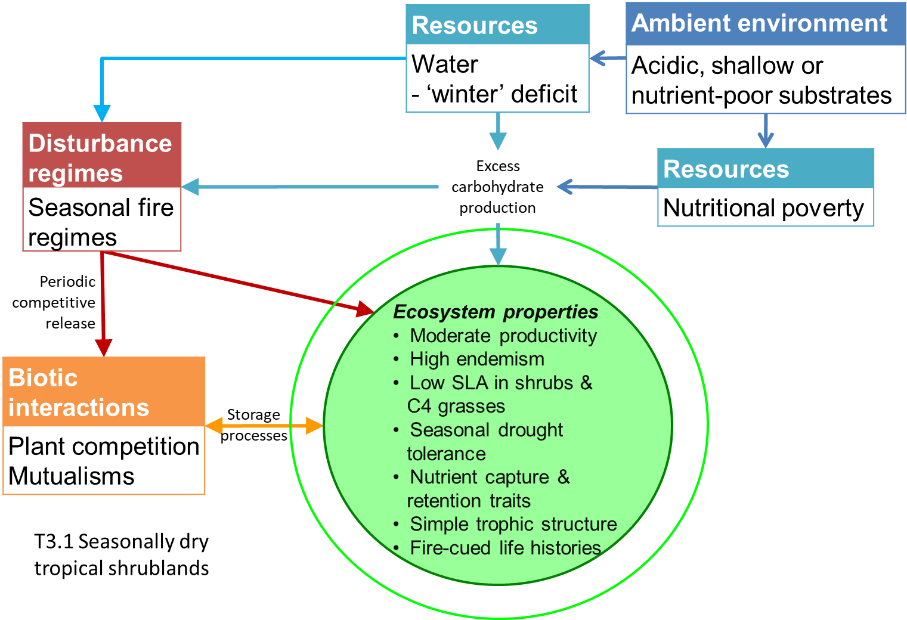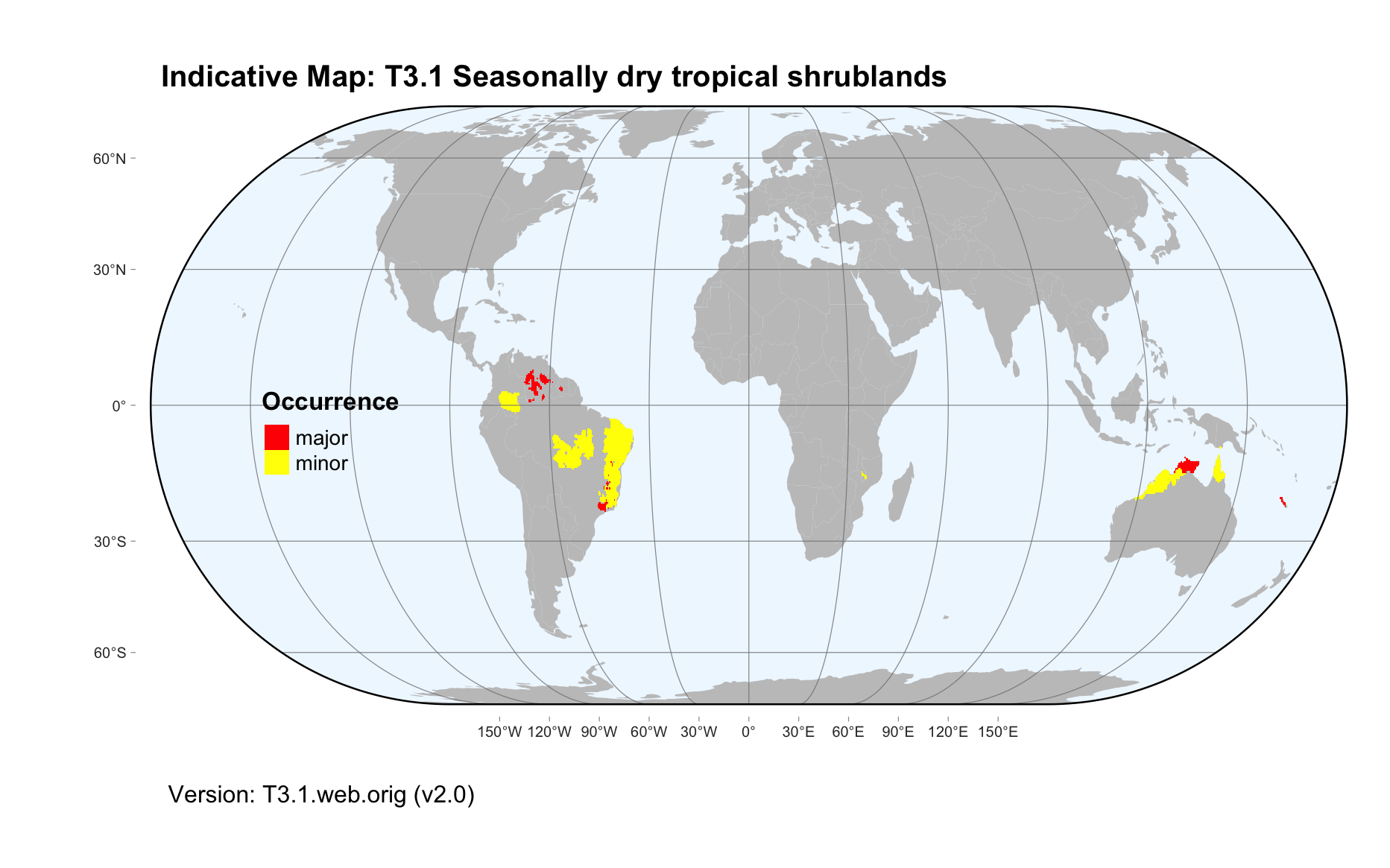Global ecosystem typology
Alternative site for the Global ecosystem typology with additional information for ecosystem profiles and indicative maps.
This site is maintained by jrfep
T3.1 Seasonally dry tropical shrublands
Biome: T3. Shrublands and shrubby woodlands biome
Contributors:
(texts)
Occurring on nutrient-deficient soils of tropical regions, these fire-prone shrublands and low forests are associated with dry tropical winters, often occurring in a matrix with savannas (T4.2) or tropical dry forests (T1.2). Dominated by small-leaved sclerophyll shrubs and grasses, plants have traits to capture and conserve nutrients, such as cluster roots and carnivorous forms. Birds, reptiles and seed-eating small mammals dominate the vertebrate fauna, with few vertebrate herbivores. Periodic fires are cues for life-history processes of plants and animals, and help maintain species composition and nutrient cycling.
Key Features
Mostly evergreen, sclerophyll shrublands on nutrient-poor soils, C4 grasses can be important.
Overview of distribution
Global seasonally-dry tropics : South America, Australia, oceanic high islands.
Profile versions
- v1.0 (2020-01-20): DA Keith
- v2.0 (2020-05-31): DA Keith; J Russell-Smith
- v2.01 ():
- v2.1 (2022-04-06): DA Keith; J Russell-Smith Full profile available at official site
Main references
Selected references for this functional group:
Morellato LPC, Silveira.FAO (2018) Plant life in campo rupestre: New lessons from an ancient biodiversity hotspot Flora 238: 1-10
Russell-Smith J, Ryan PG, Klessa D, Waight G, Harwood R (1998) Fire regimes, fire-sensitive vegetation, and fire management of the sandstone Arnhem Plateau, monsoonal northern Australia Journal of Applied Ecology 35, 829-846
Fernandes GW (2016) Ecology and conservation of mountaintop grasslands in Brazil Springer: Berlin
Diagrammatic assembly model

Maps
Maps are indicative of global distribution patterns are not intended to represent fine-scale patterns. The maps show areas of the world containing major (coloured red) or minor occurrences (coloured yellow) of each ecosystem functional group. See general notes on maps.
There are 2 alternative versions of the indicative map for this functional group, please compare description and sources below.
T3.1.IM.orig_v2.0
Datasets
- Resolve-Ecoregions-2017
Map references
Dinerstein E, Olson D, Joshi A, Vynne C, Burgess ND, Wikramanayake E, Hahn N, Palminteri S, Hedao P, Noss R, Hansen M, Locke H, Ellis EE, Jones B, Barber CV, Hayes R, Kormos C, Martin V, Crist E, Sechrest W, Price L, Baillie JEM, Weeden D, Suckling K, Davis C, Sizer N, Moore R, Thau D, Birch T, Potapov P, Turubanova S, Tyukavina A, de Souza N, Pintea L, Brito JC, Llewellyn Barnekow Lillesø JP, van Breugel P, Graudal L, Voge M, Al-Shammari KF, Saleem M (2017) An Ecoregion-Based Approach to Protecting Half the Terrestrial Realm, BioScience 67: 534–545. DOI:10.1093/biosci/bix014. Data-set available on-line
T3.1.web.orig_v2.0

Datasets
- Resolve-Ecoregions-2017
Map references
Dinerstein E, Olson D, Joshi A, Vynne C, Burgess ND, Wikramanayake E, Hahn N, Palminteri S, Hedao P, Noss R, Hansen M, Locke H, Ellis EE, Jones B, Barber CV, Hayes R, Kormos C, Martin V, Crist E, Sechrest W, Price L, Baillie JEM, Weeden D, Suckling K, Davis C, Sizer N, Moore R, Thau D, Birch T, Potapov P, Turubanova S, Tyukavina A, de Souza N, Pintea L, Brito JC, Llewellyn Barnekow Lillesø JP, van Breugel P, Graudal L, Voge M, Al-Shammari KF, Saleem M (2017) An Ecoregion-Based Approach to Protecting Half the Terrestrial Realm, BioScience 67: 534–545. DOI:10.1093/biosci/bix014. Data-set available on-line
Check: the Glossary / Profile structure / the public document